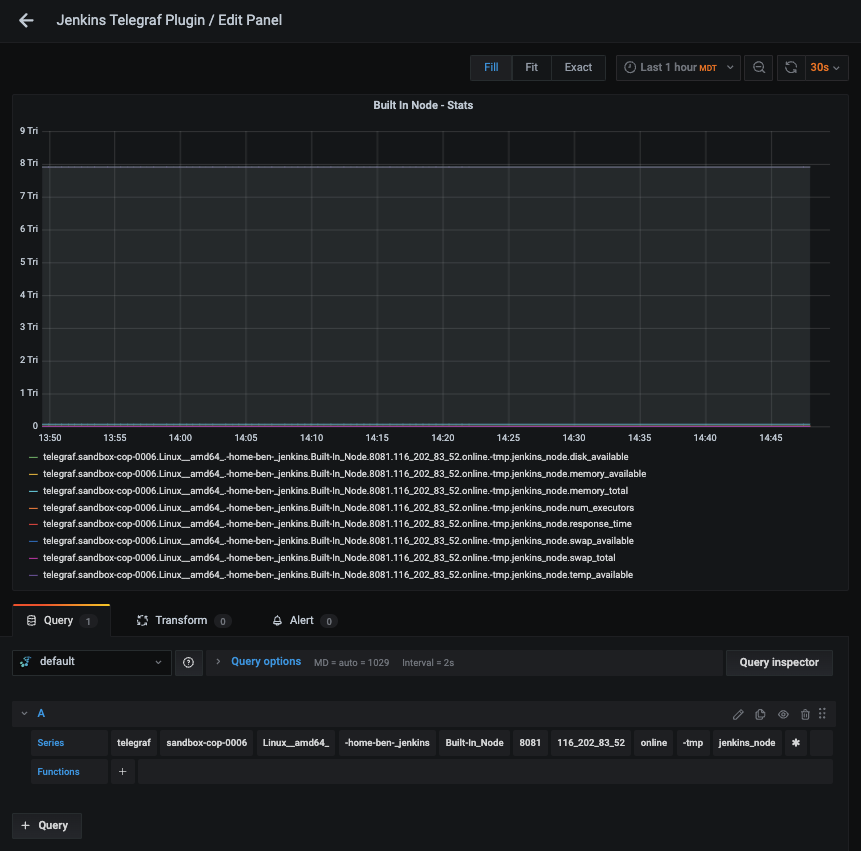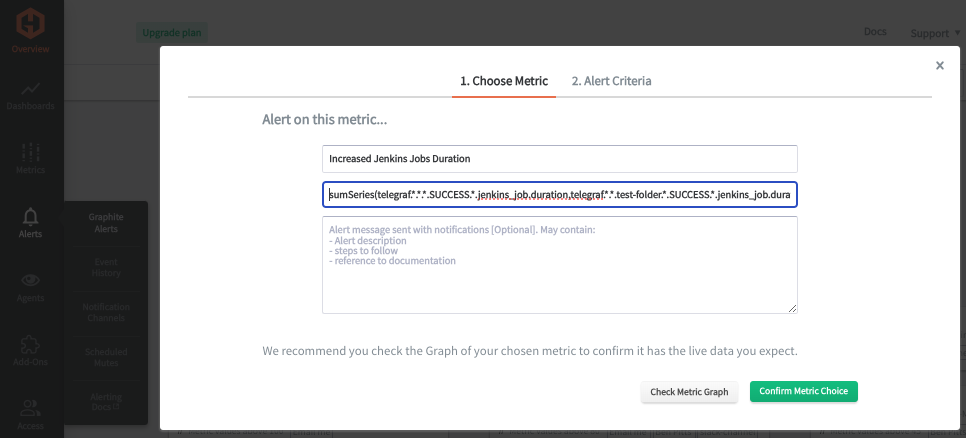Table of Contents
Introduction
Monitoring Jenkins jobs and nodes is foundational to maintaining a robust, efficient, and secure CI/CD pipeline. It enables DevOps teams to stay proactive about system health, optimize performance, manage resources effectively, and adhere to security and compliance standards.
In this article, we'll detail how to use the Telegraf agent to collect performance metrics from your Jenkins environment and forward them to a data source.
Getting Started with the Telegraf Agent
Telegraf is a plugin-driven server agent built on InfluxDB and can collect and send metrics/events from databases, systems, devices, and a range of popular technologies. Telegraf is written in Go, compiles into a single binary with no external dependencies, and requires minimal memory footprint. It is compatible with many operating systems and has many helpful output plugins and input plugins for collecting and forwarding a wide variety of performance metrics.
Install Telegraf (Linux/Redhat)
/etc/telegraf/.wget https://dl.influxdata.com/telegraf/releases/telegraf_1.21.2-1_amd64.deb
sudo dpkg -i telegraf_1.21.2-1_amd64.deb
RedHat/CentOS
wget https://dl.influxdata.com/telegraf/releases/telegraf-1.21.4-1.x86_64.rpm
sudo yum localinstall telegraf-1.21.4-1.x86_64.rpm
Configure an Output
You can configure Telegraf to output to various sources, such as Kafka, Graphite, InfluxDB, Prometheus, SQL, NoSQL, and more.
In this example, we will configure Telegraf with a Graphite output. If you're not currently hosting your own data source, you can start a 14-day free trial with Hosted Graphite by MetricFire to follow along with these next steps.
A Hosted Graphite account will provide the data source, include Hosted Grafana as a visualization tool, and offer an alerting feature.
To configure the Graphite output, locate the downloaded telegraf configuration file at /etc/telegraf/telegraf.conf and open it in your preferred text editor. Then, you will need to make the following changes to the file:
Locate and comment out the line:
# [[outputs.influxdb]]
Then, uncomment the line:
[[outputs.graphite]]
Next, uncomment and edit the server line to:
servers = ["carbon.hostedgraphite.com:2003"]
Finally, uncomment and edit the prefix line to:
prefix = "<YOUR_API_KEY>.telegraf"
Configure and Launch Jenkins
This article assumes that you are already using an active instance of Jenkins. If you need to install/launch Jenkins for testing purposes, here is a quick guide to get up and running in a Linux environment:
- install prerequisites (java JDK):
- sudo apt-get install openjdk-11-jdk
- add GPG key:
- sudo wget -q -O - https://pkg.jenkins.io/debian-stable/jenkins.io.key | sudo apt-key add -
- add repo:
- sudo sh -c 'echo deb http://pkg.jenkins.io/debian-stable binary/ > /etc/apt/sources.list.d/jenkins.list'
- Confirm Jenkins repo file is configured correctly:
- sudo vi /etc/apt/sources.list.d/jenkins.list
- the file should include this line: deb https://pkg.jenkins.io/debian-stable binary/
- manually launch Jenkins instance:
- sudo wget http://mirrors.jenkins.io/war-stable/latest/jenkins.war
- java -jar jenkins.war
- If the default port 8080 is already being used by another process, use a different http port:
- java -jar jenkins.war --httpPort=8081
- connect to the Jenkins UI:
- the terminal output from the above command provides a PW to connect to the UI
- in the browser, navigate to: http://<instance-ip>:8080/
- follow the UI prompts to create credentials (username/PW) and log in
- now you can create a few test jobs/nodes to produce some metrics
Configure the Jenkins Input Plugin
Telegraf has many input plugins that can collect a wide range of data from many popular technologies and 3rd party sources. In this example, we'll demonstrate how to configure the Jenkins plugin.
Within your telegraf.conf file, locate and uncomment the [[inputs.jenkins]] line:
[[inputs.jenkins]]
Then you can uncomment the 'URL' and credential lines; the default path is:
url = "http://<jenkins-instance-IP>:8080"
username = "xxxxxxxx"
password = "xxxxxxxx"
response_timeout = "5s"
Save your changes, and then start Telegraf using the following command to see if there are any configuration errors in the output:
telegraf --config telegraf.conf
Telegraf will now be forwarding node metrics for: disk_available, temp_available, memory_available, memory_total, swap_available, swap_total, response_time, num_executors, and job metrics for: duration, number, and result_code.
See the official GitHub repository for more information and configuration options for this input plugin.
Use Hosted Graphite by MetricFire to Create Custom Dashboards and Alerts
MetricFire is a monitoring platform that enables you to gather, visualize, analyze, and alert on metrics from sources such as servers, databases, networks, devices, and applications. Using MetricFire, you can effortlessly identify problems and optimize resources within your infrastructure. Hosted Graphite by MetricFire removes the burden of self-hosting your monitoring solution, allowing you more time and freedom to work on your most important tasks.
- Once you have signed up for a Hosted Graphite account and used the above steps to configure your server with the Telegraf Agent, metrics will be forwarded, timestamped, ingested, and aggregated into the Hosted Graphite backend.
- They will be sent and stored in the Graphite format of metric.name.path <numeric-value> <unix-timestamp> provides a tree-like data structure and makes them easy to query.
- These metrics can be found in your Hosted Graphite account, where you can use them to build custom Alerts and Grafana dashboards.
Create Dashboards in Hosted Graphite's Hosted Grafana
First, locate your metrics in the Hosted Graphite Metrics Search UI. Then, navigate to Dashboards => Primary Dashboards and select the + button to build a new panel:
Then you can use the query UI to select a graphite metric path (the default data source will be the hosted graphite backend if you are accessing Grafana through your Hosted Graphite account):

NOTE: the Hosted Graphite datasource supports wildcard (*) searches to grab all metrics that match a specified path.
Now you can apply Graphite functions to these metrics, like aliasByNode() to reformat the metric names on the graph and exclude() to omit a specified pattern:
Grafana has many additional options, like configuring dashboard variables and annotations. You can also use different visualizations, modify the display, set the units of measurement, and much more.
Also, Hosted Graphite has a pre-configured dashboard for Telegraf metrics in their Dashboard Library. Once this dashboard is generated in your account, you can identify it in your Primary Dashboards to see system metrics (CPU, mem, disk) displayed. These system performance metrics come automatically with a Telegraf => Graphite configuration:
See the Hosted Graphite dashboard docs for more details.
Creating Graphite Alerts
In the Hosted Graphite UI, navigate to Alerts => Graphite Alerts to create a new alert. Name the alert, add one of your graphite metrics to the alerting metric field, and add a description of what this alert is:
Then, select the Criteria tab, which will set the threshold, and select a notification channel. The default notification channel is the email you used to sign up for the Hosted Graphite account. Still, you can easily configure a channel for Slack, PagerDuty, Microsoft Teams, and more. See the Hosted Graphite docs for more details on notification channels:
Conclusion
Monitoring your Jenkins instances is essential for ensuring the CI/CD pipeline operates smoothly and efficiently. It identifies and resolves performance bottlenecks, security vulnerabilities, and infrastructure issues. It also supports optimal resource utilization and facilitates continuous improvement by providing valuable insights into the health and efficiency of your automation processes.
Tools like dashboards and alerts complement this monitoring by providing real-time visualization, proactive identification of issues, historical trend analysis, and facilitating informed decision-making, all of which are essential for maintaining a robust and efficient network infrastructure.
Sign up for a free trial, and start monitoring your infrastructure today! You can also book a demo and talk to the MetricFire team directly about your monitoring needs.








